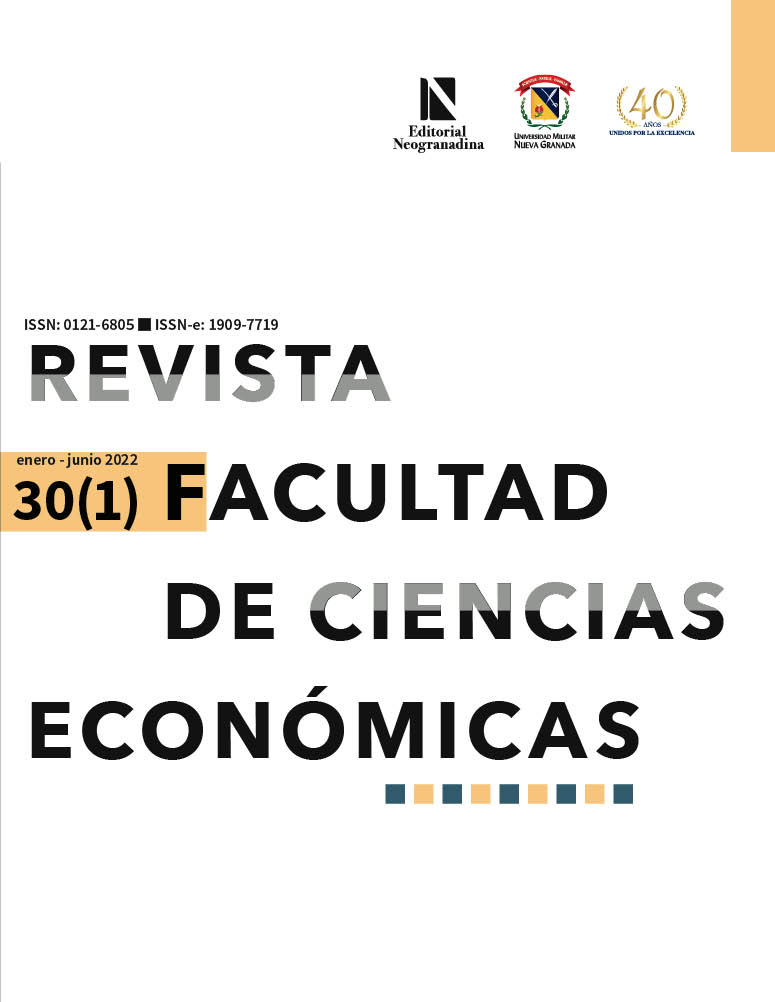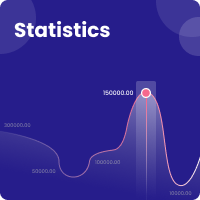Changes in country risk rating: Do they affect the volatility of emerging markets?
Case: MILA, CIVETS and BM and FBOVESPA
Abstract
The integration of the stock markets creates relationships through agreements that provide greater economic benefits to the countries and offer investors more opportunities to invest their capital surpluses based on expected profitability and risk diversification. It is then that the country risk becomes an indicator for decision making, since the risk rating agencies evaluate the existing conditions in an economy and its links with others. Therefore, the purpose of this paper is to assess the impact of the change in country risk rating on the prices of equity investment assets in the BM and FBOVESPA-MILA-CIVETS markets in the 2009-2018 period. The foregoing, carried out through a model based on structural change aimed at analyzing whether a break in the time series is identified on the dates of the event. In addition, using Gaussian copulas, the correlation between the risk rating and the average expected returns in different scenarios is verified. The result this generates is that there is an impact and a structural break in the time series of the emerging markets studied, derived from the change in rating; however, when the emerging market has greater depth and volatility, greater significance is identified in the event.
Downloads
References
Acosta, A., Barráez, D., Pérez, D. y Urbina, M. (2015). Riesgo país, fundamentos macroeconómicos e incertidumbre en economías latinoamericanas. Monetaria, Centro de Estudios Monetarios Latinoamericanos, 37(2), 164-195.
Ángel, V. (2000). Turbulencias financieras y riesgos de mercado. Financial Times, Prentice Hall.
Asness, C. S. e Israelov, R. (2011). International Diversification Works (Eventually). Financial Analysts Journal, 67(3), 1-23. DOI: https://doi.org/10.2469/faj.v67.n3.1
Ayala, J., Iturralde, T. y Rodríguez, A. (2006). Análisis de la percepción del riesgo país. Revista Europea de Dirección y economía de la Empresa, 15(3), 123-138.
B3 Brasil Bolsa Balcao. (28 de Mayo de 2018). B3 Brasil Bolsa Balcao. http://www.b3.com.br/es/
BM y FBOVESPA. (2017). Informe Anual BM y FBOVESPA 2017. BM y FBOVESPA.
Breymann, W., Díaz, A. y Embrechts, P. (2003). Dependence structures for multivariate high-frequency data in Finance. Quantitative Finance, 3(1), 1-14. DOI: https://doi.org/10.1080/713666155
Brooks, R., Faff, R., Hillier, D. y Hillier, J. (2004). The National Market Impact of Sovereign Ratings Changes. Journal of Banking and Finance, 28(1), 233-250. DOI: https://doi.org/10.1016/S0378-4266(02)00406-5
Brown, R., Durbin, J. y Evans, J. (1975). Techniques for testing the constancy of regression relationships over time. Journal of the Royal Statistical Society, B 37, 149-163. DOI: https://doi.org/10.1111/j.2517-6161.1975.tb01532.x
Cantor, F., y Packer, R. (1996). Determinants and impact of sovereign credit ratings. Federal Reserve Bank of New York Economic Policy Review, 2(2), 37-53. DOI: https://doi.org/10.2139/ssrn.1028774
Cardona, D. (2012). Dependencia estructural en los mercados bursátiles de Colombia y Estados Unidos: una aproximación usando cópulas. Cuadernos de Economía, 31, 147-178.
Ceballo, G., Pérez, D., y Gutiérrez, B. (2017). Impacto del Índice Riesgo País en el Mercado accionario colombiano. Invertigación administrativa, 46(119). DOI: https://doi.org/10.35426/IAv46n119.02
Chan, K., y Chen, N.-f. (1991). Structural and Return Characteristics of Small and Large Firms. Journal of Finance, 46(4), 1467-1484. DOI: https://doi.org/10.1111/j.1540-6261.1991.tb04626.x
Chen, L., Gaver, J., y Pottier, S. (2018). An Investigation of the Short‐Run and Long‐Run Stock Returns Surrounding Insurer Rating Changes. The Journal of Risk and Insurance, 85(1), 35-67. DOI: https://doi.org/10.1111/jori.12138
Cherubini, U., Lucian, E. y Vecchiato, W. (2004). Copula Methods in Finance. Chichester: Jhon Wiley y Sons Ltd. DOI: https://doi.org/10.1002/9781118673331
Chow, G. (1960). Tests of Equality Between Sets of Coefficients in Two Linear Regressions. Econometrica, 28(3), 591-605. DOI: https://doi.org/10.2307/1910133
Christopher, R., Suk-Joong, K. y Wu, E. (2012). Do Sovereign Credit Ratings Influence Regional Stock and Bond Market Interdependencies in Emerging Countries? Journal of International Financial Markets, Institutions and Money, 22(4), 1070-1089. DOI: https://doi.org/10.1016/j.intfin.2012.01.003
Creighton, A., Gower, L. y Richards, A. (2007). The Impact of Rating Changes in Australian Financial Markets. Pacific-Basin Finance Journal, (15), 1-17. DOI: https://doi.org/10.1016/j.pacfin.2006.04.003
Cruz de Souza, F., Dal-Ri, F. y Borba, J. (2013). The Informational Content of Credit Ratings in Brazil: An Event Study. Revista Brasileira de Finanças, 11(4), 503-526.
Damasceno, D., Artes, R., y Minardi, A. (2008). Determinação de rating de crédito de empresas brasileiras com a utilização de índices contábeis. Revista de Administração da Universidade de São Paulo, 43(4), 344-355.
Daza, J. (2014). Crecimiento y rentabilidad en el mercado emergente brasileño. Cudernos de Gestión, 15(2), 91-112. DOI: https://doi.org/10.5295/cdg.130444jd
De Souza, L., Freitas, F. y Lanzer, E. (2017). Rebaixamento do Risco Soberano Brasil pelas Agências de Classificação de Risco - Impactos na Economia Brasileira. Espacios, 38(22), 1-14.
Díaz, S., Gallego, A., y Pallicera, N. (2008). Máster en Mercados Financieros. Universitat Pompeu Fabra. Riesgo País en Mercados Emergentes.
Dichev, I. y Piotroski, J. (2001). The Long-run Stock Returns Following Bond Ratings Changes. Journal of Finance, (56), 173-203. DOI: https://doi.org/10.1111/0022-1082.00322
Durán, A. (1984). Derecho de Integración. Universitaria.
Elayan, F., Hsu, W. y Meyer, T. (2003). The informational content of credit rating announcements for share prices in a small market. Joournal of Economics and Finance, 27(3), 337-356. DOI: https://doi.org/10.1007/BF02761570
Elkhoury, M. (2008). Credit Rating Agencies and their potential impact on developing countries. UNCTAD Discussion Papers, 186.
Emawtee, B. y Brooks, R. (2015). The credit risk–return puzzle: Impact of credit rating announcements in Australia and Japan. Pacific-Basin Finance Journal, 35(A), 37-55. DOI: https://doi.org/10.1016/j.pacfin.2014.09.001
Erb, C., Harvey, C. y Viskanta, T. (1995). Country risk and global equity selection. Journal of Portfolio Management, 74-83. DOI: https://doi.org/10.3905/jpm.1995.409504
Eslava, D. (2012). Tesis de grado. Estudio del rating de la deuda soberana en Colombia, Indonesia, Perú y Sudafrica. Universidad EAN.
Fama, E. (1991). Efficient Capital Markets II. The Journal of Finance, 46(5), 1575-1617. DOI: https://doi.org/10.1111/j.1540-6261.1991.tb04636.x
Fernández, M. A. y Matallín, J. C. (2000). Gestión óptima de carteras internacionales ante la integración de los mercados europeos. Investigaciones Europeas de Dirección y Economía, 87-100.
Ferreira, M. y Gama, P. (2007). Does sovereign debt ratings news spill over to international stock markets? Journal of Banking and Finance, 31(10), 3162-3182. DOI: https://doi.org/10.1016/j.jbankfin.2006.12.006
Freitas, A., y Minardi, A. (2013). The Impact of Credit Rating Changes in Latin American Stock Markets. BAR - Brazilian Administration Review, 10(4), 439-461. DOI: https://doi.org/10.1590/S1807-76922013000400005
Fu, F. (2009). Idiosyncratic risk and the cross-section of expected stock returns. Journal of Financial Economics, 91(1), 24-37. DOI: http://doi.org/10.1016/j.jfineco.2008.02.003
García, S. y Otero, J. (2006). Factores condicionantes en la medicion del riesgo soberano en los países emergentes. Estudio de Economía Aplicada, 24(1), 245-272.
Halek, M. y Eckles, D. (2012). Determinants of Abnormal Reactions to Rating Downgrades: An Investigation of Insurer Ratings. Working Paper.
Halek, M. y Eckles, L. (2010). Effect of Analysts’ Ratings on Insurer Stock Returns: Evidence of Asymmetric Responses. Journalof Risk and Insurance, 77(4), 801-827. DOI: https://doi.org/10.1111/j.1539-6975.2010.01368.x
Hansen, B. (1992). Testing for Parameter Instability in Linear Models. Journal of Policy Modeling, 14(4), 517-533. DOI: https://doi.org/10.1016/0161-8938(92)90019-9
Hansen, B. (2001). The New Econometrics of Structural. Journal of Economic Perspectives, 15(4), 117-128. DOI: https://doi.org/10.1257/jep.15.4.117
Ismailescu, I. y Kazemi, H. (2010). The Reaction of Emerging Market Credit Default Swap Spreads to Sovereign Credit Rating Changes. Journal of Banking y Finance, 34, 2861-2873. DOI: https://doi.org/10.1016/j.jbankfin.2010.05.014
Jorion, P. y Zhang, G. (2007). Information effects of bond rating changes: the role of the rating prior to the announcement. Journal of Fixed Income, 16(4), 45-59. DOI: https://doi.org/10.3905/jfi.2007.683317
Julio, J., Lozano, I. y Melo, L. (Diciembre de 2013). Global Risk Appetite and EMBI-Colombia: Evidence on a Structural Break and the Fiscal Policy Role. Ensayos sobre Política Económica, 31(72), 67-73. DOI: https://doi.org/10.1016/S0120-4483(13)70005-8
Kim, J., Shamsuddin, A. y Lim, K. (2011). Stock return predictability and the adaptive markets hypothesis: Evidence from century-long U.S. data. Journal of EmpiricalFinance, 18(5), 868-879. DOI: https://doi.org/10.1016/j.jempfin.2011.08.002
Kim, S., y Wu, E. (2008). Sovereign credit ratings, capital flows and financial sector development in emerging markets. Emerging Markets Review, 9, 17-39. DOI: https://doi.org/10.1016/j.ememar.2007.06.001
Kliger, D., y Sarig, O. (2000). The Information Value of Bond Ratings. Journal of Finance(55), 2879-2902. DOI: https://doi.org/10.1111/0022-1082.00311
Korkmaza, T. Ç. (2012). Return and volatility spillovers among CIVETS stock markets. Emerging Markets Review, 13(2), 230-252. DOI: https://doi.org/10.1016/j.ememar.2012.03.003
Kose, M., Prasad, E. y Terrones, M. (2009). Does openness to international financial flows raise productivity growth? J. Int. Money Finance, 28(4), 554-580. DOI: https://doi.org/10.1016/j.jimonfin.2009.01.005
Kramer, W., Ploberger, W. y Alt, R. (1998). Testing for Structural Change in Dynamic Models. Econometrica, 56, 1355-1369. DOI: https://doi.org/10.2307/1913102
Kräussl, R. (2005). Do Credit Rating Agencies Add to the Dynamics of Emerging Market Crises? Journal of Financial Stability, 1(3), 355-385. DOI: https://doi.org/10.1016/j.jfs.2005.02.005
Lapitz, R., Gorfinkiel, D., Acosta, A., Florez, M. y Gudynas, E. (2005). El otro riesgo pais, indicadores y desarrollo de la economìa global. Coscoroba.
Lee, C.-H., y Chou, P.-I. (2018). Financial Openness and Market Liquidity in Emerging Markets. Finance Research Letters(25), 124-130. DOI: https://doi.org/10.1016/j.frl.2017.10.024
Levi, M. (1998). Finanzas Internacionaes. McGraw-Hill.
Levine, R. (1996). Foreign banks, financial development and economic growth. International Financial Markets, 24-254.
Lopera, C., Jaramillo, M. y Arcila, L. (2009). Selección de un modelo cópula para el ajuste de datos bivariados dependientes. DYNA, 76(158), 253-263.
Martín, J. L. y Téllez, C. (2006). Finanzas internacionales. Thomson.
Melo, L., y Misas, M. (2004). Modelos estructurales de inflación en Colombia: estimación a través de mínimos cuadrados flexibles. Borradores de Economía, 283.
Mendoza, A., y Galvanovskis, E. (2014). La cópula ged bivariada:una aplicación en entornos de crisis. El trimestre económico, 81(323), 721-746. DOI: https://doi.org/10.20430/ete.v81i323.128
Ministerio de Industria, comercio y turismo España. (Diciembre de 2019). Ministerio de Industria, Comercio y Turismo, España. https://www.icex.es/icex/es/navegacion-principal/todos-nuestros-servicios/informacion-de-mercados/paises/navegacion-principal/noticias/NEW2017708192.html?idPais=ZA
Murcia, F., Murcia, F. y Borda, J. (2013). The Informational Content of Credit Ratings in Brazil: An Event Study. Revista Brasileira de Finanças, 11(4), 503-526. DOI: https://doi.org/10.12660/rbfin.v11n4.2013.9264
Nasr, A., Cunado, J., Demirer, R. y Gupta, R. (2018). Country Risk Ratings and Stock Market Returns in Brazil, Russia, India, and China (BRICS) Countries: A Nonlinear Dynamic Approach. Risks, MDPI, Open Access Journal, 6(3), 1-22. DOI: https://doi.org/10.3390/risks6030094
Nelsen, R. (1999). An Introduction to Copulas. Springer. DOI: https://doi.org/10.1007/978-1-4757-3076-0
Oficina de Información Diplomática del Ministerio de Asuntos Exteriores. (2019). Ficha País: Sudáfrica. http://www.exteriores.gob.es/Documents/FichasPais/SUDAFRICA_FICHA%20PAIS.pdf
Pagan, J. y Soydemir, G. (2000). On the linkages between equity markets in Latin America. Applied Economics Letters, 7(3), 207-210. DOI: https://doi.org/10.1080/135048500351816
Park, D. (2016). Credit Rating and Monetary Policy Transmission to Equity Markets: Evidence from the Emerging Market. Journal Global Economic Review, 46(1), 33-46. DOI: https://doi.org/10.1080/1226508X.2016.1259008
Partnoy, F. (2006). How and why credit rating agencies are not like other gatekeepers. San Diego Legal Studies, 7-46.
Prasad, K., Shang, J., y Kose, A. (Mayo de 2003). http://www.nber.org/~wei/data/prwk2003/prwk2003_spanish.pdf.
Reisen, H., y Von Maltzan, J. (1999). Boom and Bust and Sovereign Ratings. OECD Development Centre, Technical Paper, 148. DOI: https://doi.org/10.1111/1468-2362.00028
Richards, A. y Deddouche, D. (1999). Bank Rating Changes and Bank Stock Returns: Puzzling Evidence from Emerging Markets. IMF Working Paper, 2(3), 337-363. DOI: https://doi.org/10.1177/097265270300200304
Rodríguez, A., y San Martín, N. (2008). ¿Reflejan los índices de riesgo país las variables relevantes en el desencadenamiento de las crisis externas? Un análisis sobre el periodo 1994-2001. Cuadernos de Gestión, 8(2), 65-80.
Salazar, F., y Guzmán, L. (2015). Globalización financiera y crisis económica ¿producto de los cambios en las estructuras bancarias a partir de 1980? Dimensión Empresarial, 13(1), 113-134. DOI: https://doi.org/10.15665/rde.v13i2.531
Santilli, E.(2016). Determinantes del riesgo país en economías latinoamericanas. (Tesis inédita de maestría). Universidad Nacional de La Plata. Argentina
Sensoy, A. (2015). Impact of sovereign rating changes on stock market co-movements: the case of Latin America. Journal Applied Economics, 48(28), 2600-2610. DOI: https://doi.org/10.1080/00036846.2015.1125437
Shi, A. (2006). Dissertação (Mestrado em Engenharia Elétrica). Pontifícia Universidade Católica do Rio de Janeiro. Predição do grau de ratings corporativos.
Soares de Lima, M. (2012). Brasil, os BRICS e a institucionalização do conflito internacional. BRASIL. Ministério das Relações Exteriores. O Brasil, os BRICS e a agenda internacional, 175-186.
Soares, J. y Camargos, M. (2018). Impacto da alteração do rating soberano no custo de capital de empresas brasileiras, 2005-2015. Pretexto, 19(3), 99-118. DOI: https://doi.org/10.21714/pretexto.v19i3.5408
Taylor, S. (1986). Modelling financial time series. (2 ed.). World Scientific.
Thapa, C., y Poshakwale, S. S. (2010). International equity portfolio allocations and transaction costs. Journal of Banking y Finance, 34(11), 2627-2638. DOI: https://doi.org/10.1016/j.jbankfin.2010.05.004
Tokarnia, M., y Oliveira, K. (2018). Fitch reduz rating de crédito do Brasil. En Agência Brasil. http://agenciabrasil.ebc.com.br/es/economia/noticia/2018-02/fitch-rebaja-calificacion-crediticia-de-brasil
Van Agtmael, A. (2007). The Emerging Markets Century: How a New Breed of World-Class Companies is Overtaking the World. Free Press.
Vidya, S., Sumit, M. y Rajesh, S. (2019). Institutional investors and international investments in emerging economy firms: A behavioral risk perspective. Journal of World Business, 54(4), 322-334. DOI: https://doi.org/10.1016/j.jwb.2018.12.002
Vieira, E. (2011). Las naciones o mercados emergentes CIVETS. Borrador de Administración (49), 5-26.
Zivot, E. y Wang, J. (2007). Modeling financial time series with S-Plus. Springer Science y Business Media.
Ӧzatay, F., Ӧzmen, E. y Sahinbeyoglu, G. (2009). Emerging market sovereign spreads, global financial conditions and U.S. macroeconomic news. Economic Modelling, 26, 526-531. DOI: https://doi.org/10.1016/j.econmod.2008.10.008

Copyright (c) 2022 Revista Facultad de Ciencias Económicas

This work is licensed under a Creative Commons Attribution-NonCommercial-NoDerivatives 4.0 International License.











